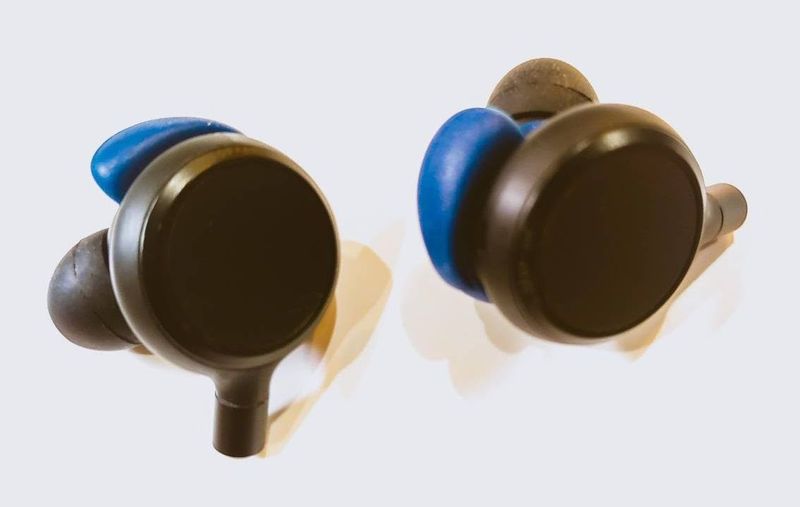
REVIEW – Drop has partnered with Axel Grell to create true wireless stereo (TWS) in-ear monitors (IEMs) that have fantastic sound characteristics. Like many TWS, these earbuds do much more than just reproduce sound, but how does it perform in these other areas? I have one to review. Read on to see what I think!
What is it?
The Drop + Grell TWS1X is an audiophile-grade TWS IEM. The product is a collaboration between Grell Audio and Drop product design. While some developers may emphasize the battery life, ingress protection, or noise cancellation proficiency, the Drop + Grell TWS1X emphasizes its sound quality. The TWS1X achieves its characteristic sound by using custom drivers and digital signal processing. In addition to offering hybrid ANC, the TWS1X comes in a case that supports wireless charging.
What’s in the box?
- Charging case
- USB-A to USB-C charging cable
- 3 pairs of silicone ear tips (S, M, L)
- 2 pairs of foam eartips (M, L)
- 3 pairs of wingtips (various fits)
- Quick Start Guide
- Safety Manual
Hardware specs
- IEM type: Closed-back
- Drivers: Custom-designed 10 mm dynamic drivers
- Glass touchpad and touch-sensor operation
- Maximum SPL: 105 dB (1 kHz)
- Frequency response: 4 Hz – 22 kHz
- THD: < 0.06 % (1 kHz, 100 dB SPL)
- Noise-canceling: Psycho-acoustical Noise Annoyance Reduction (NAR)
- Microphones: Patent-pending Multilayer Turbulence Eliminator (MTE) microphone array
- Active noise-canceling: 2 microphones per side
- Microphones: Matched pairs, low noise
- Microphone frequency response: 100 Hz – 10 kHz
- Microphone pick-up pattern: Beamforming array
- Connectivity: Bluetooth 5.2
- Bluetooth codecs supported: SBC, AAC, aptX Adaptive, LHDC
- Playback time (Via AAC, ANC, or Transparent Mode off): 5 hours
- Battery life (earphones and case combined, ANC off): 45 hours
- Wireless charging compatible
- Charging time (earphones from the case): 1.5 hours
- IPX4 splash-proof
- Weight (per earbud): 0.3 oz (8 g)
- Weight (case): 2.3 oz (66 g)
Design and features
Unboxing
At first glance, the Drop + Grell TWS1X appears to come in a plain cardboard box.
 However, upon opening the box, one discovers that the brown color of the box is simply the color and texture chosen by Drop for their packaging. It could be that Drop is making a statement about providing unique and creative design to the most basic aspect of whatever it is they focus on, whether it is a TWS IEM or the box that they come in. Or, it could just be that they wanted to make the box look appealing.
However, upon opening the box, one discovers that the brown color of the box is simply the color and texture chosen by Drop for their packaging. It could be that Drop is making a statement about providing unique and creative design to the most basic aspect of whatever it is they focus on, whether it is a TWS IEM or the box that they come in. Or, it could just be that they wanted to make the box look appealing.
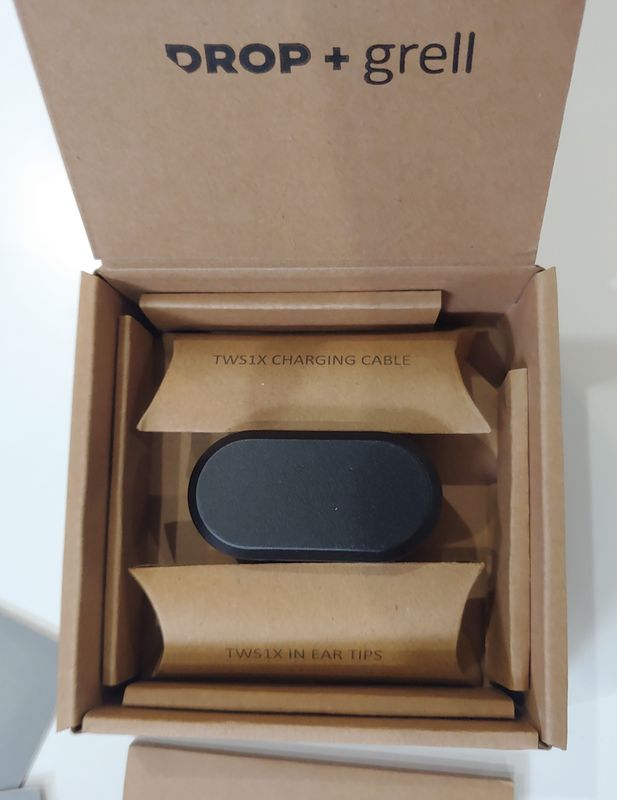
Note that the product is labeled TWS/1, which is the model of the Grell Audio unit, but is sold as the TWS1X by Drop. I think the unit I received was an early marketing unit that did not have all the naming figured out.
Design
The Drop + Grell TWS1X IEMs come packaged in the case. The case is fabricated from aluminum and has a plastic bottom to permit wireless charging. The case is bigger than the Apple AirPods Pro case and not as easy to pocket because of its squared sides.
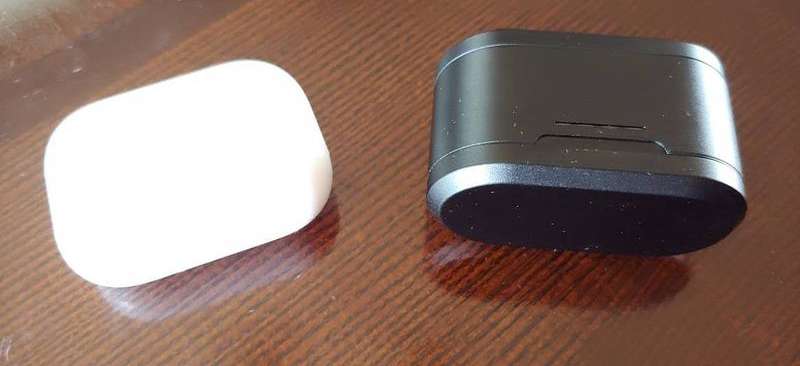 The case weighs 2.65 oz. versus the AirPods 2 oz. The hinge of the lid is sturdy and when it is opened the LEDs in front of the case illuminate, then show the charge, then show the Bluetooth status. Pushing the lid back past 90 degrees open causes it to lock in an open position.
The case weighs 2.65 oz. versus the AirPods 2 oz. The hinge of the lid is sturdy and when it is opened the LEDs in front of the case illuminate, then show the charge, then show the Bluetooth status. Pushing the lid back past 90 degrees open causes it to lock in an open position.
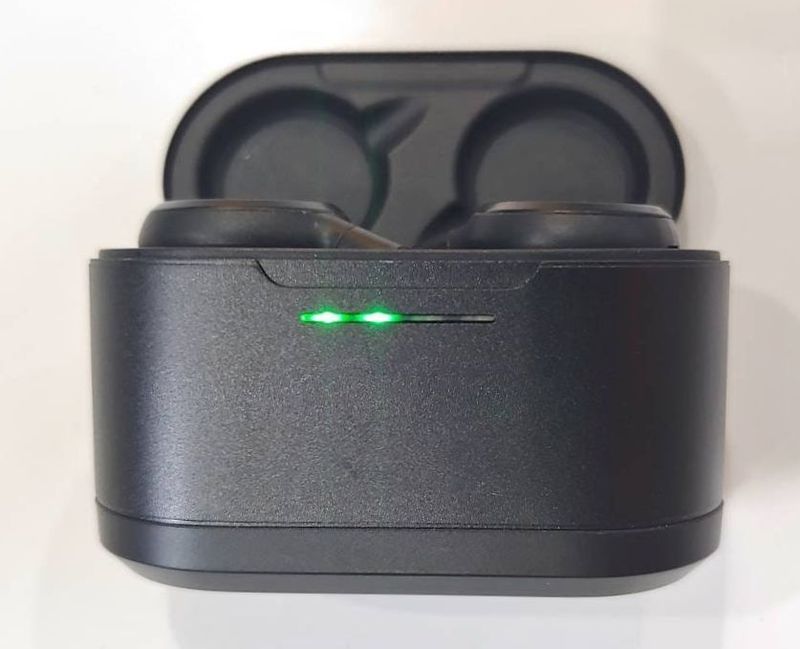
Many reviewers have commented on this already but the left earbud is on the right side and vice versa. I can imagine that this has something to do with the placement of the circuitry inside that holds the LEDs. If I were designing this, I’d prefer to have the LEDs at the base of the case and the left earbud on the left side rather than the current arrangement. To overcome this design I’ve been opening the case towards me so the left earbud is on the left side.
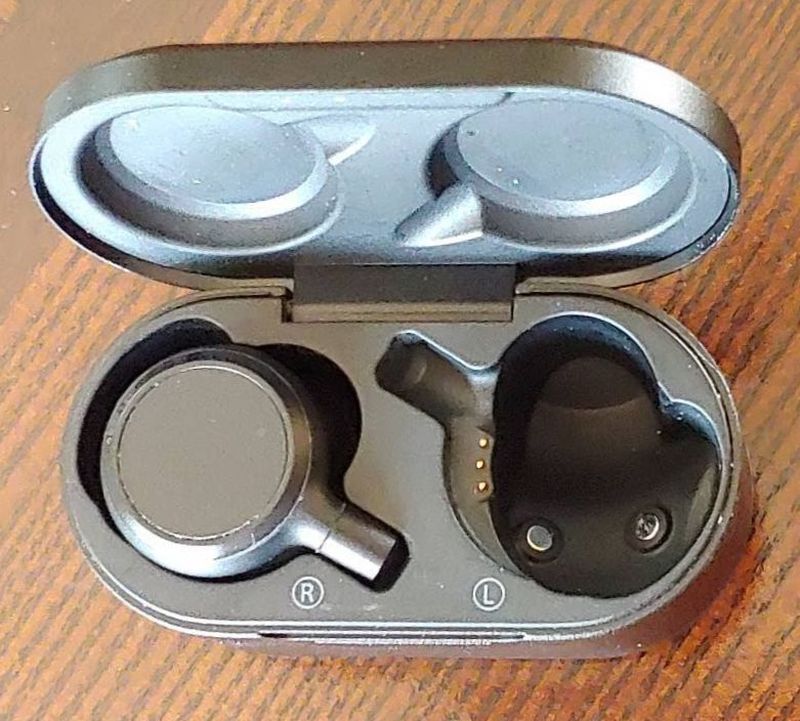
Inside each side of the Drop + Grell TWS1X IEMs case are two strong magnets to hold the earbud in place and 3 pogo contacts for charging. I have found that the wells of the case are deep enough to hold the largest supplied foam tip and the wingtips as long as the foam tips are installed all the way.
The earbuds themselves are a very subtle design with only a tiny easter egg-sized DROP + grell label on the control surface bezel. There are no LEDs on the earbuds. Each earbud weighs 0.25 oz. versus the AirPods 0.2 oz. (with similar-sized silicone tips and no wings). They are rated IPX4. I did drop them in the sink for a second and it didn’t break it, but wouldn’t recommend making a habit out of this.
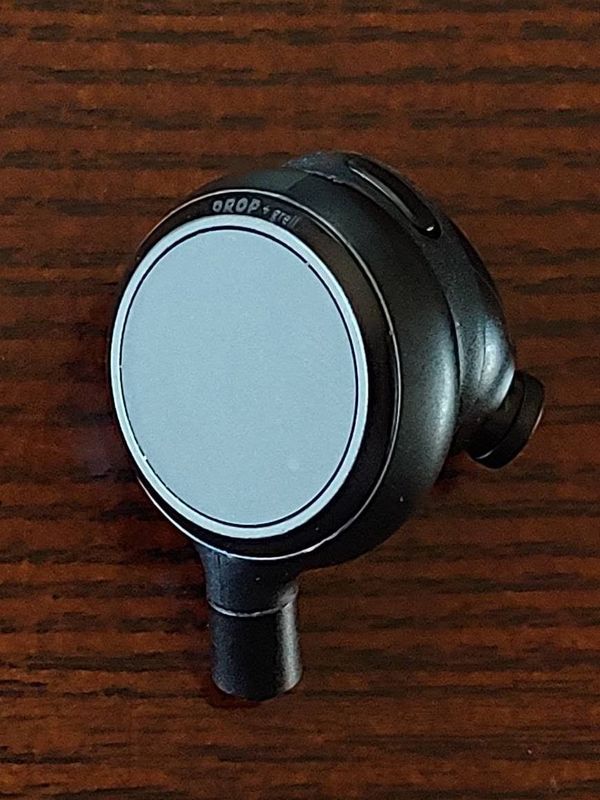
I do feel that the fit on these could be better, but that may just be my ears. The tips of the earbuds measure about 6 mm and the TWS1X includes three pairs of silicone tips and two pairs of foam tips. The TWS1X also comes with “wingtips” designed to hold the earbuds into your ears more securely than with the ear tip alone.
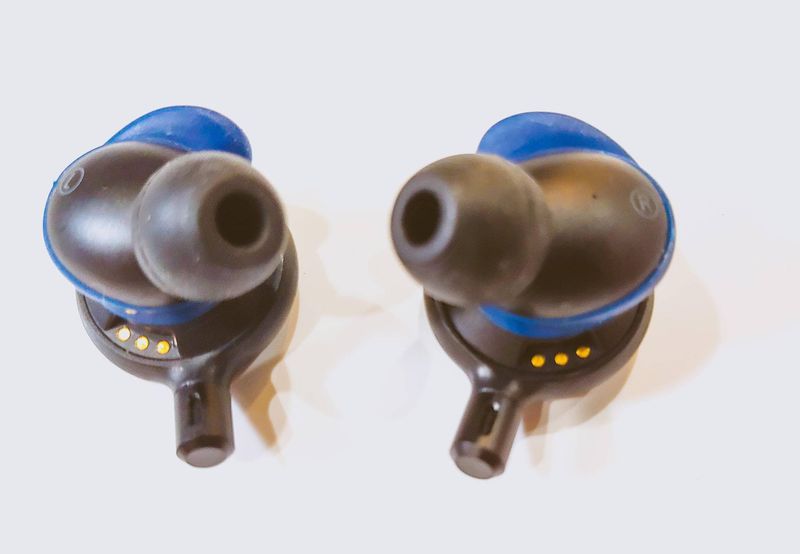
The product includes a total of three sets that are all the same size but that have 3 levels of compressibility, from a sparse fin type design to a solid block of silicone. A pair of black silicone coverings are also included to fill the slot meant for wingtips when they are not installed.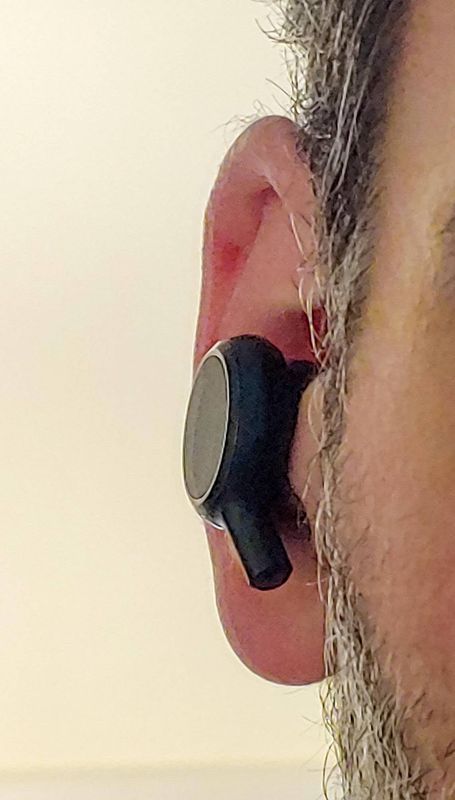
When installed correctly there is a small microphone boom that points towards the wearer’s mouth. This is a “Multilayer Turbulence Eliminator (MTE) microphone array, ” which is bigger than the bump on the Jabra Elite Line, but smaller than the stems on the Apple AirPods Pro or standard AirPods.
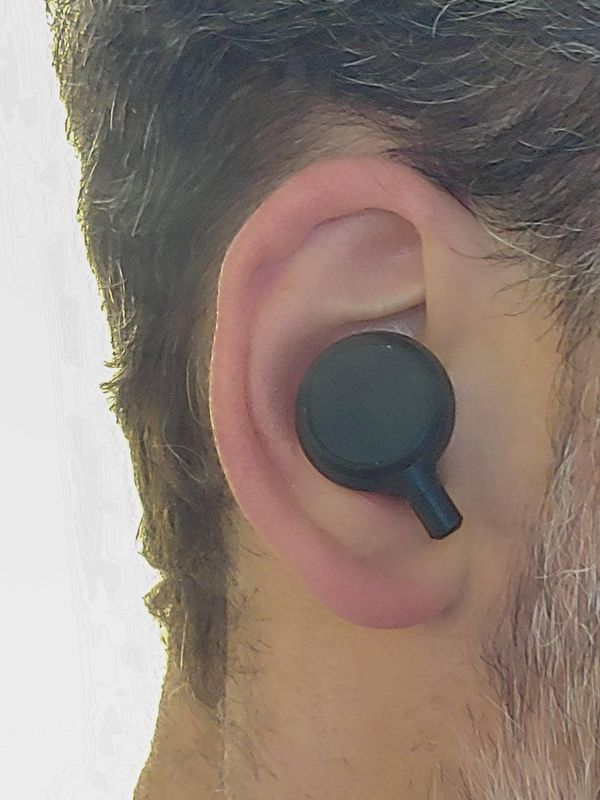
Operation
The Drop + Grell TWS1X IEM’s control surface uses a combination of swipes and touches to control volume, playback, transparency modes, telephone modes, and digital assistant access. The control of each function is specific to using either the left or right earbud; the controls are not ambidextrous. The controls seem to be responsive and not overly finicky, but the earbuds are susceptible to false signals if they are left on their backs while not being listened to. In addition to swipes and taps, the mode control requires that the left earbud be pressed for transparent mode, held for ANC mode, and held longer for the NAR mode. The earbud gives tone feedback for when the ANC or NAR is selected. The modes work with NAR operating on top of ANC and transparent mode toggling whatever ANC or NAR mode is active. To turn all modes off with NAR on, ANC mode must be turned on and then turned off. Because the track selection swipe is on the same earbud as the transparent selection press, there is a chance that the track can be changed by accident while changing these modes.
I did not experience any connectivity problems with the Bluetooth. I was able to connect effortlessly to Apple and Android devices and was able to use AAC and Apt X codecs. Note that this isn’t TWS+ so that the right earbud connects through the left earbud, which is paired to the device.
The TWS1X is complemented by the SoundID app and software. The settings for the custom equalization are uploaded to the earbuds themselves and will work no matter what the earbuds are paired to. The customized equalization can also be turned off. Selecting the equalization is done by listening to sample tracks and then picking the best sound from a selection of the same music played with different equalization settings.
Performance
The Drop + Grell TWS1X IEMs sound is very good in comparison with some of today’s most popular good-sounding TWS. I listened to the TWS1x in comparison with the Apple AirPods Pro (A2190) and there is a noticeable smoothness, warmth, and depth present in the TWS1X compared with the Apple AirPods Pro. My comparison was based on a flat SoundID profile and used the AAC codec. At one point during the testing of the TWS1X I needed to remove an earbud to see if the sound was coming from my phone because the soundstage was so expansive. I have experienced this with DTS:X before but never with audio equipment right out of the box.
While listening to music on each of these earphones I noticed that the TWS1X has a bit more bass response than the AirPods but not a distortive or rumbling base that some cheaper earbuds have. The transition from bass to treble is very smooth and seems to provide a well-balanced response across the entire spectrum. Tones are clear and distinct. The midrange is not overpowered by the bass and the high end is identifiable and clear but not shrill. Note that while the frequency response on these TWS is stated to be 4 Hz – 22 kHz, my middle-aged ears probably tucker out around 15 kHz.
Latency was not noticeable while watching YouTube videos on the paired device.
While the sound reproduction performance is above average (as it should be for a product that costs $199) the ANC capabilities are average to sub-par. I can tell that there is some ANC working when listening to the ambient sound next to a soda machine and turning the ANC on and off. There is a noticeable dip in the noise of the refrigeration unit but in my opinion, not enough. Drop has replied to criticism about the ANC implementation stating that the purpose of designing the ANC in this way is to not have the ANC impair the frequency response of the TWS1X. I have difficulty understanding this logic. If there is disturbing ambient noise while listening to music then either the noise or the ANC implementation will impact the frequency response. I rather have the earbuds filter as much outside noise as possible. Drop also advertises that noise-canceling is revolutionized with Grell’s innovative psycho-acoustical Noise Annoyance Reduction (NAR) system. I was not able to appreciate the benefit of NAR in any environment – I was not able to discern the effects of NAR at any point.
The transparency mode works to retransmit the ambient sounds to the speakers, but there is occasionally a persistent static in the left earphone that makes this mode completely unusable. After a while, it just seems to fade away. I’ve also noticed that there is some noise in the Left earbud when the ANC is on. This too will just fade away over time but it can be a bit frustrating when it is first put on.
The Bluetooth range was impressive. There are still occasional stutters of the feed and this seems to be independent of the distance from the paired device. Drop has stated that they are preparing to address this issue in May 2022 via a software upgrade. One thing I have noticed is that there have been 2 software updates in a month and another one, to version 3.x is expected in May. I am happy that there is continued support for this product but perplexed that there need to be so many patches in such little time.
The microphone recording on the TWS1X was able to filter out the sounds of a neighborhood leaf blower and some wind but at the expense of some clarity. Note that the noise reduction that is part of Teams was turned off while making this recording. I also made a recording using a voicemail system and the recorded audio for the TWS1X and the phone microphone sounded identical.
Battery life was horrible for the 2.3 software, but the use time has improved to about the 5 hour mark for the 2.7 version. The earlier software version was constantly charging the earbuds in the case.
What I like
- Great sound profile
- good selection of ear tips
What I’d change
- Option of audiophile or maximum isolation ANC
- Improved ambient mode
- Improved microphones
- Use ANC to determine when earphones are removed
- Revise case design
Final thoughts
The starting point for a lot of audiophile equipment is the 1/4″ plug. A cable filled with oxygen-free copper and unicorn horsehair leads to a pair of large, open-cup headphones. You don’t bother with closed cups when it is just you, your chardonnay, a Maxell tape, and Richard Wagner’s “Ride of the Valkyries” because you want the best sound. The point of these TWS is that reproducing the recorded sound precisely is the most important design criteria. Some other TWS promise to stay in your ears no matter what, to provide excellent microphones for phone use, fantastic Bluetooth reception, steller batter life, or to provide excellent noise suppression. While the Drop Grell does support ANC (and NAR), a microphone for calls, a battery, and some parts to improve ear fit, it does not excel at providing great function in any of these things. What you are sure to get through, is really good sound. An audiophile does not usually question the cost of quality sound, and in keeping with this premise, Axel Grell famously engineered a $53,000 pair of headphones. While the $199 cost of these TWS may not be a barrier for some, there are comfortable, small, feature-rich TWS that may be better daily drivers than these devices. However, if you want the best sound out of a TWS (that I’ve ever heard) you should give the Drop + Grell TWS1X a try.
Price: $199
Where to buy: Drop
Source: The sample of this product was provided by Drop
